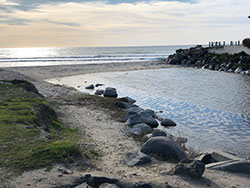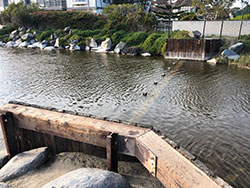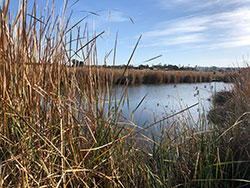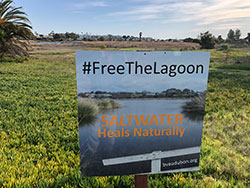Buena Vista Lagoon Ecological Reserve, San Diego County

Mouth of Buena Vista Lagoon

Weir near the mouth of Buena Vista Lagoon

Cattails growing on edge of lagoon

Sign encouraging the reopening of lagoon
The Buena Vista Lagoon Ecological Reserve in San Diego County sits between the cities of Oceanside to the north and Carlsbad to the south. It’s historic because it was the state’s first-ever reserve, created in 1968. Recently it has become considered noteworthy, if not historic, for another reason. Homeowners in that area, the San Diego Association of Governments (SANDAG), CDFW and several other groups came to an agreement after years of dispute on how the lagoon should be altered so it thrives well into the future.
“It’s a really exciting situation, and it leads me to believe that people will do the right thing when push comes to shove and not just look out for their own personal interests,” said CDFW Reserve Manager Gabriel Penaflor.
“To me, it's a good-news story in terms of bringing polarized stakeholders that had disparate views, together to say, we are now moving forward together,” said Planner Keith Greer of SANDAG.
“It’s been a contentious issue for decades,” said Buena Vista Audubon Executive Director Natalie Shapiro. “It’s just wonderful that we’re all on the same page.”
Like lagoons up and down that part of San Diego County, Buena Vista took in runoff from hills to the east and fed water to the west into the Pacific Ocean. But in the ‘40’s a weir was added at the mouth by nearby landowners, so the lagoon essentially became freshwater only. In the ‘70’s that weir was replaced with an even stronger blockage that made the lagoon even more like a lake, and not a body of water with an ocean connection.
But what may have been a beautiful sight for residents, became an environmental, health and flooding concern for others. As the lagoon grew increasingly shallow because of increasing sediment and silt, cattails exploded in growth, taking away about 60 acres of open water over the last 30 years. Over the next 30 years the entire lagoon would more likely resemble a marsh as the open water areas as sediment continued to rise and vegetation continued to spread. Fresh water and thick cattails also bring another problem.
“There's a large mosquito breeding ground in the lagoon and a lot of that has to do with all the cattails there, so a big concern is public health,” said CDFW’s Penaflor. “The cattails are just choking out the lagoon. They’re so big and thick they stop the larvicide that the county drops from reaching the water and affecting the mosquito larva. It’s a very arduous process to remove the cattails – they come back very fast. If it’s a saltwater lagoon the cattail wouldn’t be able to thrive in a saltwater environment. So hopefully this restoration can address public health concerns with the mosquitoes as well as improve the overall environment,” he said.
It was 2001 when CDFW started feasibility studies about restoring the lagoon to allow saltwater back into the system, but that process would prove to be anything but a simple fix. Because the weir is on private property, those property owners would have to be part of any solution to remove the device and introduce saltwater, and early suggested improvements weren’t well received. When CDFW discussions with landowners stalled, the cities of Oceanside and Carlsbad reached out to SANDAG for assistance in getting the weir-removal project re-energized. But being involved and making progress can be two very different things.
“It was going to be a big showdown between these two sides. One wanted saltwater, one wanted fresh water,” said Greer of SANDAG. “It was property owners versus stakeholders, and agencies versus everybody. Our board did something very smart, looking back. They stopped any kind of action on the project and said, ‘we’re going to give you guys one year, and you come back to us with a solution, or we’re going to make a decision at the SANDAG level.’ That did two things. First, it showed all the stakeholders that our board was serious and that if everyone couldn’t get on the same page, they were going to make a decision. The second, it gave the stakeholders time to reconvene and have access to our technical information to have meaningful conversations about the best thing to do. We sat with the homeowners and crafted a process moving forward. We met with wildlife agencies, and environmental groups and moved forward to allow the lagoon to get open to the ocean, while still meeting property owners needs out there.”
Though CDFW involvement in the negotiations met with resistance early on, Regional Manager Ed Pert played a major role in the discussions roughly 15 years later.
“He and I sat down with the owners and kind of crafted a process going forward,” said Greer. “We listened to their needs and to how we could help meet them. At the beginning, the homeowners felt like they weren't being listened to, they felt like the government was steamrolling them. I think Ed’s demeanor makes him really open to listening to people.”
Pert is quick to deflect the credit.
“It has been a long road in getting to the point where we can take concrete steps to restore the lagoon, and I very much appreciate the perseverance and efforts from those who made this happen,” said Pert. “Keith Greer and landowners who own the weir at the mouth of the lagoon in particular. Keith brought everyone to the table and kept us talking. Those folks deserve all the credit for finding a path forward,” he said.
The agreement reached on what’s called the Modified Saltwater Alternative would accomplish two things. First, it would reintroduce saltwater to the lagoon through a larger channel and the removal of the weir. Second, the lagoon will maintain a freshwater feel through a dredging operation that removes more than 900,000 cubic yards of sediment. Those deeper sections of the lagoon will remain filled with seawater at low tide. The agreement also calls for significant amounts of vegetation to be removed, which will help solve the mosquito issue.
“We're elated that the saltwater alternative has been approved, because it'll allow the lagoon to be reconnected with the ocean,” said Shapiro. “Returning the lagoon to a saltwater environment will greatly enhance the biological diversity, which will be very beneficial to bird populations. At the Audubon Society we're interested in bird habitat and currently, it's just not providing enough habitat diversity for birds. For example, there's an endangered species called the Ridgway’s rail which adapted to freshwater habitat, but it does really well with saltwater habitat. The big thing that's lacking right now are mudflats which will be created once there are tidal flows and that's important for shorebirds, like the Snowy Plover.”
Because this was never going to be a simple fix, huge hurdles remain before Buena Vista Lagoon is once again salty. While preliminary engineering is complete, state and federal permits must be obtained, and 5 million dollars is needed to make the project bid ready for construction. The final step is the highest of those hurdles; locating the 80 million dollars it will take for actual construction. Because SANDAG has recently restored another San Diego-area lagoon and is preparing to start work on another, Greer is confident the money will be found through state and federal sources.
“One year to be shovel-ready as we call it,” said Greer. “Within two years, I think we'll have a solid commitment for that 80 million dollars. Five years from now, we’ll probably be under construction.”
All those years of discussions and negotiations that eventually led to agreements and handshakes, on a project that would scare away many, is what makes Greer happy.
“Bringing all those groups together, that’s the fun part,” he said.
###
Media Contact:
Tim Daly, CDFW Communications, (916) 201-2958
CDFW Photos